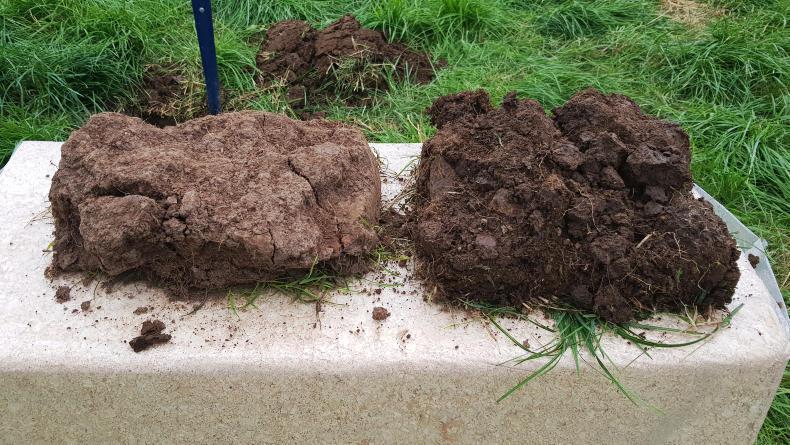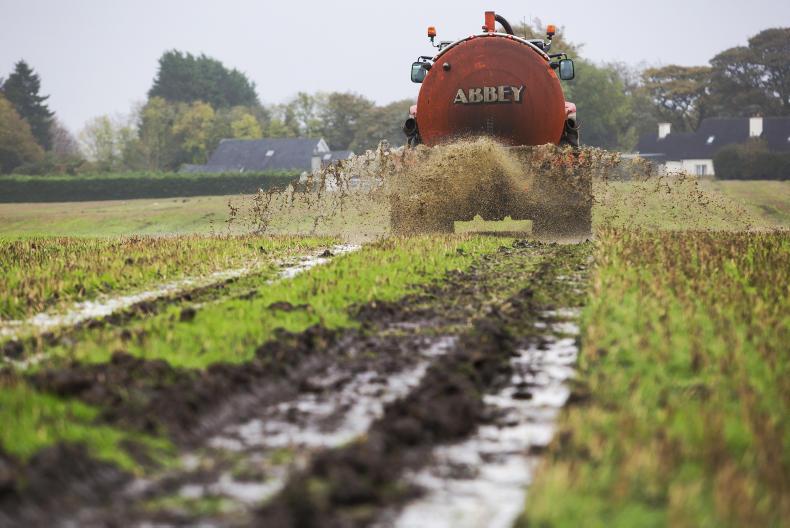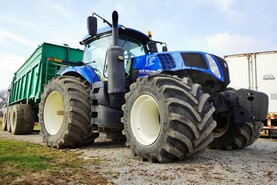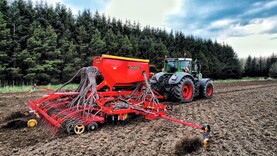Research proves that slurry application in spring has the most effect in relation to nutrient recovery in grass. This, along with lack of storage, leaves farmers edging to get out spreading early as possible.
Slurry tankers have increased in size along with increasing slurry volumes and tractor sizes. The average tanker size has increased from 1,600 gallons and is now somewhere in the region of 2,500 gallons. The increase in size aids the efficiency of slurry spreading, yet it can also cause problems that are not always visible to the surface. Perhaps more time should be taken to protect the soil and its structure instead of increasing tanker size to speed up spreading times.

The topsoil on the left is severely compacted, but the topsoil on the right has no compaction and has plenty of space between soil aggregates.
Typically, a 2,500-gallon, single-axle tanker will have an unladen weight of 4000kg, although some brands may be heavier. This size tanker will carry approximately 11,000kg of slurry, meaning the combined laden weight is 15,000kg. Generally, a tanker’s axles are positioned to carry 80% of the overall weight. This means a downward force of 3,000kg is applied to the tractor drawbar, leaving a force of 12,000kg on the tanker’s axle, 6,000kg on each wheel.
Keeping these weights in mind, it is important to select a tyre with low ground pressure to prevent soil damage. Compaction from heavy loading can have an effect on soil down to a depth of 1m.
Tyres
Tyres have two main functions on agricultural machines:
To transmit power, delivering traction. To carry and distribute the load of the machine on the soil.
Michelin Ultraflex Tyre wall technology, allows for lower inflation pressures which lower ground pressure as result.
But tyres also contribute to machine stability, steering and suspension.
Tyres can play a big role in reducing soil compaction. Tyre technology has advanced well in recent years with flexible wall technology allowing for lower operating tyre pressures. This technology was pioneered by Michelin over a decade ago, delivering greater scope for reducing ground pressure.
Designing tyre carcases that are capable of running at a greater level of deflection allows a given size tyre to have a lower inflation pressure. These tyres are denoted by the letters IF (increased flexion) or VF (very high flexion) beside the tyre size figures. This can have a significant impact on the contact patch and ground pressure that these tyres exert.
Michelin now uses this technology in a number of tyre ranges for tractors and combines (Xeobib and Axiobib) and other manufacturers have adopted this technology over the last few years. The increased flattening of the carcase allows a decrease in ground pressure. Therefore, the lower the tyre pressure the lower the pressure on the soil.
The quality of an agricultural tyre lies in its ability to carry heavy loads at low pressure. In fact, the pressure in the tyre is close to the mean pressure exerted on the soil, eg if the pressure in a tyre is 14.5 psi, the pressure exerted on the soil by the tyre will be around 1lb per square inch.
Michelin claims that its Axiobib range has a 16% bigger footprint. Two 650/85 R38 tyres were measured – one with IF technology and the other not. The Axiobib with IF technology required 1.6-bar (23PSI) inflation, while the standard tyre required 2.4-bar (35PSI) pressure, both tested with a 6,500kg load.
Umbilical slurry spreading
Umbilical systems carry many advantages. One tractor operates in the field with no excess weight as no tanker is present. Often, the spreading tractor is fitted with low ground pressure tyres, carrying just its own weight and the spreading implement attached.
The only traffic to pass through the gate is upon entering the exiting the field compared to multiple times with a tanker.

Umbilical slurry spreading with floatation tyres reduces soil compaction.
Umbilical spreading allows more ground to be covered in a short time due to the constant flow of slurry and wider spreading widths as well as the ability to travel on hilly ground that tankers may not.
Spreading slurry on tillage crops is best done through this type of system.
Heavy soils should also benefit from using an umbilical system. A concern with heavy soils is that if the soils are at field capacity for water, then some run-off can occur.
Dealing with compacted soils
Compacted soils have a direct correlation with yield reduction. Studies by Teagasc show yield reductions in grassland of up to 30% in some cases.
Where compaction has already occurred, the first step is to prevent further compaction whether other actions such as soil loosening are to be used.
Moderately compacted soils may recover themselves over time where the actions of soil wetting and drying, freeze/thaw, earthworm activity and root growth can all contribute to soil loosening.
The decision to mechanically loosen the soil should not be taken lightly, as research from Teagasc has shown that these actions have disadvantages and do not necessarily return the soil to its original state. Subsoiling in unsuitable conditions can create a pan layer, leaving an impermeable layer for roots to travel through.
Research proves that slurry application in spring has the most effect in relation to nutrient recovery in grass. This, along with lack of storage, leaves farmers edging to get out spreading early as possible.
Slurry tankers have increased in size along with increasing slurry volumes and tractor sizes. The average tanker size has increased from 1,600 gallons and is now somewhere in the region of 2,500 gallons. The increase in size aids the efficiency of slurry spreading, yet it can also cause problems that are not always visible to the surface. Perhaps more time should be taken to protect the soil and its structure instead of increasing tanker size to speed up spreading times.

The topsoil on the left is severely compacted, but the topsoil on the right has no compaction and has plenty of space between soil aggregates.
Typically, a 2,500-gallon, single-axle tanker will have an unladen weight of 4000kg, although some brands may be heavier. This size tanker will carry approximately 11,000kg of slurry, meaning the combined laden weight is 15,000kg. Generally, a tanker’s axles are positioned to carry 80% of the overall weight. This means a downward force of 3,000kg is applied to the tractor drawbar, leaving a force of 12,000kg on the tanker’s axle, 6,000kg on each wheel.
Keeping these weights in mind, it is important to select a tyre with low ground pressure to prevent soil damage. Compaction from heavy loading can have an effect on soil down to a depth of 1m.
Tyres
Tyres have two main functions on agricultural machines:
To transmit power, delivering traction. To carry and distribute the load of the machine on the soil.
Michelin Ultraflex Tyre wall technology, allows for lower inflation pressures which lower ground pressure as result.
But tyres also contribute to machine stability, steering and suspension.
Tyres can play a big role in reducing soil compaction. Tyre technology has advanced well in recent years with flexible wall technology allowing for lower operating tyre pressures. This technology was pioneered by Michelin over a decade ago, delivering greater scope for reducing ground pressure.
Designing tyre carcases that are capable of running at a greater level of deflection allows a given size tyre to have a lower inflation pressure. These tyres are denoted by the letters IF (increased flexion) or VF (very high flexion) beside the tyre size figures. This can have a significant impact on the contact patch and ground pressure that these tyres exert.
Michelin now uses this technology in a number of tyre ranges for tractors and combines (Xeobib and Axiobib) and other manufacturers have adopted this technology over the last few years. The increased flattening of the carcase allows a decrease in ground pressure. Therefore, the lower the tyre pressure the lower the pressure on the soil.
The quality of an agricultural tyre lies in its ability to carry heavy loads at low pressure. In fact, the pressure in the tyre is close to the mean pressure exerted on the soil, eg if the pressure in a tyre is 14.5 psi, the pressure exerted on the soil by the tyre will be around 1lb per square inch.
Michelin claims that its Axiobib range has a 16% bigger footprint. Two 650/85 R38 tyres were measured – one with IF technology and the other not. The Axiobib with IF technology required 1.6-bar (23PSI) inflation, while the standard tyre required 2.4-bar (35PSI) pressure, both tested with a 6,500kg load.
Umbilical slurry spreading
Umbilical systems carry many advantages. One tractor operates in the field with no excess weight as no tanker is present. Often, the spreading tractor is fitted with low ground pressure tyres, carrying just its own weight and the spreading implement attached.
The only traffic to pass through the gate is upon entering the exiting the field compared to multiple times with a tanker.

Umbilical slurry spreading with floatation tyres reduces soil compaction.
Umbilical spreading allows more ground to be covered in a short time due to the constant flow of slurry and wider spreading widths as well as the ability to travel on hilly ground that tankers may not.
Spreading slurry on tillage crops is best done through this type of system.
Heavy soils should also benefit from using an umbilical system. A concern with heavy soils is that if the soils are at field capacity for water, then some run-off can occur.
Dealing with compacted soils
Compacted soils have a direct correlation with yield reduction. Studies by Teagasc show yield reductions in grassland of up to 30% in some cases.
Where compaction has already occurred, the first step is to prevent further compaction whether other actions such as soil loosening are to be used.
Moderately compacted soils may recover themselves over time where the actions of soil wetting and drying, freeze/thaw, earthworm activity and root growth can all contribute to soil loosening.
The decision to mechanically loosen the soil should not be taken lightly, as research from Teagasc has shown that these actions have disadvantages and do not necessarily return the soil to its original state. Subsoiling in unsuitable conditions can create a pan layer, leaving an impermeable layer for roots to travel through.









 This is a subscriber-only article
This is a subscriber-only article









SHARING OPTIONS: